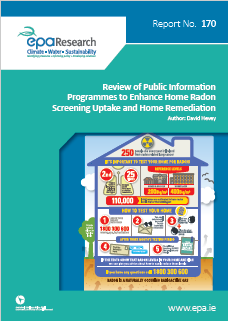Research 170 - Review of Public Information Programmes to Enhance Home Radon Screening Uptake and Home Remediation
Summary: Radon is a naturally occurring radioactive gas. It has no taste, colour or smell. It is formed in the ground by the radioactive decay of uranium which is present in all rocks and soils. The World Health Organisation has categorised radon as a carcinogen, in the same group as asbestos and tobacco smoke.

In Ireland, radon is the second cause of lung cancer (after smoking) and is linked to up to 250 cases per year. It is estimated that 7% of homes exceed the reference level of 200 Bq/m3 and about one third of the country is categorised as high risk. The EPA has a remit to raise awareness about radon in high risk areas and to encourage homeowners to test and, where necessary, remediate their homes. To this end the EPA has carried out regular awareness campaigns in priority counties. The Government’s National Radon Control Strategy endorses the continuation of awareness campaigns in high risk areas. This study has reviewed the literature on the effectiveness of local awareness campaigns regarding home radon testing uptake and home remediation rates in the context of psychological theories of risk perception and preventative behaviours.
Findings from this study indicate that the EPA programmes reflect international best practice guidelines regarding the content and process of delivering large-scale community-based multimedia programmes; the effects reported are comparable to those reported elsewhere in the literature.
The study identifies the main barriers to higher testing and remediation rates, specifically:
- The role of the state versus the individual in radon management
- Making radon risk and its management visible
- The benefits of matching interventions to the individual’s stage of decision-making regarding testing and remediation.
- The study also emphasises the limits of what can be achieved by mass-media community information programmes.